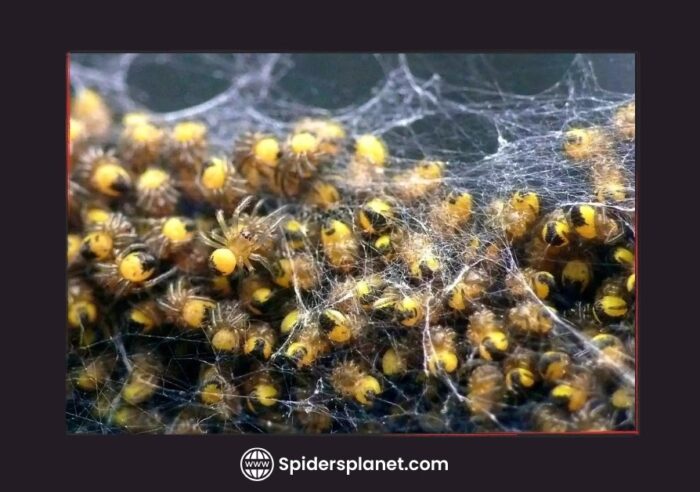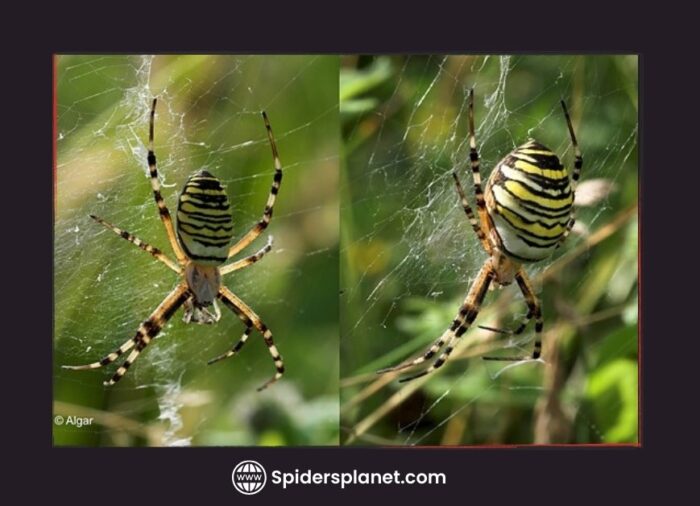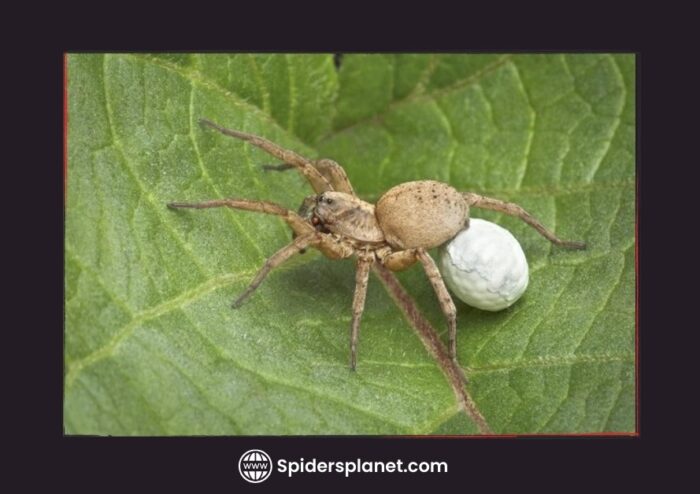Wondering if a spider is pregnant or expecting babies? Even though spiders do not have baby bumps like humans, nature gives us clues about their upcoming motherhood.
We have done thorough research on this and have figured out the secrets of spider pregnancy, finding hints in their webs and actions.
From big bellies to silk-made nurseries, we will understand the cool things about spider moms.
Get ready with your magnifying glass and curiosity as we step into the interesting world where spider families start growing, one silky clue at a time.
Let’s explore the world of pregnant spiders, starting with understanding how they get pregnant?
How do Spiders Get Pregnant? Understanding Reproduction & Lifecycle of Spiders:
Spider Courtship and Mating Rituals:
Spiders have a unique way of having babies. Unlike many land-dwelling creatures, male spiders do not directly insert sperm into females.
Instead, they spin tiny sperm webs, depositing sperm onto them. Then, using special structures on their legs called pedipalps, they transfer the sperm to females.
Male Spiders & Love Dance:
Before mating, males check if the female is the right species and ready to mate. Spiders have different ways of getting together, from fancy leg dances to using special smells to show they like each other.
In some species, they use vibrations in their webs or touch on the female’s body to communicate. If courtship is successful, the male injects sperm into the female’s abdomen.
Female spiders:
Females have two types of reproductive systems: “haplogyne” and “entelegyne“. The first has a single opening leading to storage areas for sperm, while the second has openings directly to these storage areas.
Spider eggs are usually fertilized when they are laid, and a few exceptions exist where females can activate stored sperm before laying eggs. After the female spider gets pregnant, she makes a cozy home for the eggs called an egg sac.
What is an Egg Sac?
An egg sac is like a comfy nursery, a soft and silken sanctuary where hundreds of tiny lives start growing.
Egg sacs are vital for spider survival, offering protection by shielding eggs from predators and harsh conditions. The silk walls of spider egg sacs have a dual role, serving as both protectors and caretakers.

Beyond shielding eggs from predators and harsh conditions, these silk barriers regulate temperature and humidity, establishing an ideal setting for the development of spider eggs.
Moreover, certain sacs act as safe havens for spiderlings, providing a secure shelter until they are prepared to explore the world independently.
In essence, beyond their architectural prowess, egg sacs play a crucial role in ensuring the safety and success of spider offspring.
Egg sac appearance:
Egg sacs display a delightful array of shapes and sizes, each showcasing the distinct touch of the mother spider.
Orb weavers, known for their intricate webs, craft round sacs with decorative threads or camouflaging debris.
Wolf spiders, caring arachnids, carry their egg sacs like fuzzy backpacks attached to their spinnerets, often adorned with a protective layer of brown or gray silk.
Sac spiders, true to their name, envelop their bodies in silky cocoons, creating a living, silk-swaddled nursery that mirrors the spider’s form.
These variations highlight the remarkable ways in which spider mothers safeguard and nurture their developing eggs.
How Does a Spider Make an Egg Sac?
Spiders have a special part, the spinneret, a cool organ at the spider’s back end that shoots out liquid silk.
First, the spider uses sticky silk to make a strong base for the sac. Then, with a delicate dance, it weaves layers of silk to make the sac walls.
Some spiders even add bits of leaves or stuff to hide the sac from big eaters. Inside, they might use soft silk for a cozy bed for the baby spiders.
Finally, the spider seals the sac with one last layer of silk to keep the babies comfy and warm.
It is like the spider is making a safe, silky home for its little ones with a touch of spider magic! Spiders lay up to 3,000 eggs in silk egg sacs.
Spiderlings:
Some females die after laying eggs, while others protect the sacs in various ways.
After a week or two, the sac bursts with life as the baby spiders, called spiderlings, each with eight tiny legs and big appetites, emerge as small versions of adults.
Some spiders care for their young, like wolf spiders whose babies cling to the mother’s back.
Spiders have to molt to grow, shedding their outer layer. Most spiders live only one to two years, but some, like tarantulas, can live longer, with one trapdoor spider documented to have lived for 43 years in the wild.
Growing Up:
The adventure does not stop there! Many baby spiders go on a daring flying journey called ballooning.
They let out silk threads that catch the wind, taking them like tiny parachutes. Baby spiders grow into adults by shedding their old skins, like changing out of clothes that do not fit anymore.
With each molt, they become bigger and better at hunting and building webs. Boys grow up faster than girls, who take a few years to become full-sized and ready to have babies. And so, the cycle continues.
How to Identify if a Spider is Pregnant?
Determining whether a spider is pregnant can be tricky, as there is no universal sign like a bulging belly in mammals. However, here are some clues that might indicate a spider is carrying eggs:
Physical Appearance:
Increased size and abdomen: Pregnant spiders, especially in later stages, tend to have a noticeably larger abdomen compared to males or non-pregnant females. This swollen abdomen is where they carry their developing eggs.

Change in markings: Some spider species exhibit a change in body markings or coloration when gravid (pregnant). For instance, the usually brightly colored markings on a female orb weaver spider might become duller or less distinct.
Presence of a silk sac: Many spider species, particularly orb weavers, create a silken egg sac to house their eggs. This sac, often white or cream-colored, is typically attached to the female’s web or nearby vegetation.
Behavior:
Increased appetite and web-building: Gravid spiders need more energy to nourish their developing eggs. They might exhibit increased web-building activity to capture more prey or show a heightened appetite compared to usual.
Protective behavior: Pregnant spiders are often more protective of their future offspring. They might become more aggressive when approached or display guarding behaviors near their egg sacs.
These signs are general guidelines, and not every pregnant spider will show all of them. For instance, a big belly can also mean a spider is well-fed or molting.
To accurately tell if a spider is pregnant, you often need to watch it over time and know the specific features of its species. If you are not sure about a spider’s baby-making status, it is safer not to touch it.
Most spiders are not harmful, and bothering a pregnant one could make her stressed or defensive. It is always better to be cautious and let spiders do their thing without interference.
What do Pregnant Spiders Look Like?
How many Spiderlings can emerge from an Egg Sac?
The number of baby spiders emerging from an egg sac varies widely among spider species, influenced by factors like the spider’s size, prey availability, and environmental conditions.
Small sac spiders have 10-30 eggs, orb weavers typically have 100-300 spiderlings, and some, like the giant golden orb weaver, can have up to 1,000 eggs in a sac.
Wolf spiders carry sacs with 50-100 spiderlings until they are ready to hatch. These differences show the intriguing diversity in spider reproduction.
How Long Do Spiders Get Pregnant?
The development time for spider eggs typically ranges from 30 to 50 days. The idea of “pregnancy” in spiders differs from mammals; they do not carry fertilized eggs inside their bodies for a fixed gestation period.
Instead, spiders have a “pre-oviposition period” or “embryonic development period” between fertilization and hatching.
This duration varies widely among species and is influenced by environmental factors. In tropical spiders, this period can be as short as two weeks, while in colder regions, it may extend to several months.
An extreme example is the desert wolf spider, enduring a pre-oviposition period lasting over a year in harsh, dry conditions. This diversity underscores the adaptability of spiders to their surroundings.
Also Read: Do Jumping Spiders Really Eat Dead Insects? 4 Astonishing Facts
How to Tell if a Spider is Pregnant in Different Species?
Figuring out if a spider is going to have babies can be tricky, even for experts, so it is important to watch them without bothering them. Here is a simple guide for some spider types, remembering that these are just hints and there can be differences:

If the Wolf Spider is Pregnant:
When a wolf spider is expecting, it tends to show signs like an increased appetite and a boost in web-building activity.
The gravid wolf spider constructs additional webs to catch more prey, ensuring an ample food supply for the upcoming hatchlings.
Notably, these spiders carry their egg sacs attached to their spinnerets, creating a distinctive appearance akin to a furry backpack.
These sacs, which can be round or pear-shaped and are often brown or gray, are a key characteristic of the gravid wolf spider.
If the Black Widow Spider is Pregnant:
A pregnant black widow spider may exhibit some noticeable changes in its appearance.
While female spiders normally have larger abdomens than males, a gravid black widow’s abdomen could look noticeably swollen and round.
Additionally, there might be a subtle alteration in the markings on the abdomen. The typically bright red hourglass marking may become less distinct or duller.
If the Garden Spider (Orb Weaver) is Pregnant:
Orb weaver spiders create cream-colored egg sacs attached to their webs or nearby vegetation, serving as a clear sign of impending motherhood.
In preparation, these spiders also intensify their web-building activity to accommodate the egg sac and protect the developing spiderlings.
If the House Spider is Pregnant:
A pregnant house spider may display a visibly enlarged abdomen compared to non-pregnant individuals.
This noticeable increase in size serves as an indicator of the spider’s gravid (pregnant) state.
Additionally, pregnant house spiders often exhibit protective behavior, becoming more defensive near their webs, especially if they sense a potential threat to their developing offspring.
If the Brown Recluse Spider is Pregnant:
Gravid brown recluse spiders, much like their spider counterparts, tend to show increased appetite and heightened activity in capturing prey to nourish their developing eggs.
Additionally, if you happen to come across one, the egg sac is typically white or cream-colored and has a sac-like shape.
If the Jumping Spider is Pregnant:
Jumping spiders, generally recognized for their slender bodies, may show a general sign of pregnancy by having a larger abdomen compared to non-pregnant individuals.
This fuller abdomen becomes a noticeable feature in gravid jumping spiders. Additionally, there is often a change in behavior observed; they might become less active or less jumpy, shifting their focus toward protecting and ensuring the safety of their developing offspring.
If the Huntsman Spider is Pregnant:
Huntsman spiders, known for their naturally bulky abdomens, may exhibit a gravid female with an even more prominent and round abdomen compared to their non-pregnant counterparts.
This noticeable increase in size serves as an indicator of the spider’s reproductive state. Additionally, when it comes to egg sac placement, huntsman spiders commonly lay their sacs on surfaces such as leaves or walls.
These egg sacs are typically flat, cream-colored, and resemble silken pouches.
What do Pregnant Spiders Eat?
Pregnant spiders adapt by building larger webs to capture extra prey, meeting increased nutritional demands for developing offspring.
Some species broaden their dietary preferences during pregnancy, showcasing heightened predatory instincts. While seeking protein-rich meals for egg development, their overall food intake remains proportional to size and species.
Examples include wolf spiders venturing further for ground prey and orb weavers adjusting webs for larger captures. Understanding these dietary adaptations offers insights into the behaviors of pregnant spiders and their role in the ecosystem.
What Happens If a Pregnant Spider is Killed?
Harming a pregnant spider is the loss of developing spiderlings inside the egg sac, disrupting the natural cycle of life and affecting the food chain and overall biodiversity.
As spiders play a crucial role in controlling insect populations, killing a pregnant spider may lead to a localized increase in insects, potentially upsetting the balance of the ecosystem.
Additionally, certain spider species, such as orb weavers, contribute to environmental health by building intricate webs that capture airborne debris and pollutants.
Harming these spiders can have negative repercussions on air quality and the well-being of the environment.
If concerned about spiders in the home, consider using humane methods like capturing and releasing them outside to preserve their role in the environment.
Related Post: Diving Bell Spider or Water Spider: (Argyroneta Aquatica)
FAQs:
How often do spiders reproduce?
Spider reproduction frequency varies widely, occurring from once every few years to multiple times annually.
Why do pregnant spiders explode?
Contrary to myths, pregnant spiders don’t explode; they weave protective egg sacs without any bursting.
Do pregnant spiders move?
While pregnant, spiders remain active, engaging in hunting, building, and preparation, although their movements might slow down as the sac becomes heavier.
Can spiders get pregnant by themselves?
Spider reproduction requires a mate; self-impregnation is not a spider superpower.
How many baby spiders are born at once?
The number of spider eggs in a clutch varies greatly by species, ranging from a dozen to thousands.
How do spider babies eat their mother?
Baby spiders emerge independent and start hunting on their own; they usually do not consume their mother.
Can you move a spider egg sac?
Moving a spider egg sac is generally safe, but caution is advised to avoid disturbing the nearby mother.
Final Remarks:
Learning about pregnant spiders reveals their amazing skills in making silk homes for their babies.
From special courtship dances to creating different-shaped egg sacs, spiders have unique ways of taking care of their offspring.
Watching for signs like a bigger belly or changes in behavior helps us appreciate their world.
When baby spiders come out, they go on exciting adventures and grow up by shedding their old skin.
Respecting spiders and their families from a distance allows us to enjoy the wonders of nature without causing any harm.




Leave a Reply